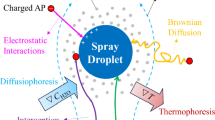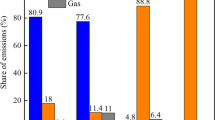Abstract
The effect of non-thermal plasma technology for particulate matter removal and nitrogen oxide emission reduction from diesel exhaust has been investigated. A sample of exhaust was cooled to the ambient temperature and passed through a dielectric barrier discharge reactor. This reactor was employed for producing plasma inside the diesel exhaust. A range of discharge powers by varying the applied voltage from 7.5 to 13.5 kV (peak–peak) at a frequency of 50 Hz has been evaluated during the experiments. Regarding the NOx emission concentration, the maximum removal efficiency has been achieved at energy density of 27 J/L. Soot, soluble organic fraction and sulphate components of diesel particulate matter have been analysed separately, and the consequence of plasma exposure on particle size distribution on both the nucleation and accumulation modes has been studied. Plasma was found to be very effective for soot removal, and it could approach complete removal efficiency for accumulation mode particles. However, when applied voltage approached 12 kV, the total number of nucleation mode particles increased by a factor of 50 times higher than the total particle numbers at the reactor inlet. This increase in nucleation mode particles increased even more when applied voltage was set at 13.5 kV.










Similar content being viewed by others
References
Akiyama H, Sakugawa T, Namihira T, Takaki K, Minamitani Y, Shimomura N (2007) Industrial applications of pulsed power technology. IEEE Trans Dielectr Electr Insul 14:1051–1064
Arai M, Saito M, Yoshinaga S (2004) Effect of oxygen on NOx removal in corona discharge field: NOx behavior without a reducing agent. Combust Sci Technol 176:1653–1665
Babaie M, Davari P, Zare F, Rahman MM, Rahimzadeh H, Ristovski Z, Brown R (2013) Effect of pulsed power on particle matter in diesel engine exhaust using a DBD plasma reactor. IEEE Trans Plasma Sci 41:2349–2358
Chae JO (2003) Non-thermal plasma for diesel exhaust treatment. J Electrostat 57:251–262
Fitzsimmons C, Shawcross J, Whitehead J (1999) Plasma-assisted synthesis of N2O5 from NO2 in air at atmospheric pressure using a dielectric pellet bed reactor. J Phys D Appl Phys 32:1136
Fushimi C, Madokoro K, Yao S, Fujioka Y, Yamada K (2008) Influence of polarity and rise time of pulse voltage waveforms on diesel particulate matter removal using an uneven dielectric barrier discharge reactor. Plasma Chem Plasma Process 28:511–522
Hui J, Tao S, Cheng Z, Wenfeng L, Ping Y, Xueke C, Schamiloglu E (2013) Experimental study of Q–V Lissajous figures in nanosecond-pulse surface discharges. IEEE Trans Dielectr Electr Insul 20:1101–1111
Inan US, Gołkowski M (2010) Principles of plasma physics for engineers and scientists. Cambridge University Press, Cambridge
Jolibois J, Takashima K, Mizuno A (2012) Application of a non-thermal surface plasma discharge in wet condition for gas exhaust treatment: NOx removal. J Electrostat 70:300–308
Kittelson DB (1998) Engines and nanoparticles: a review. J Aerosol Sci 29:575–588
Kittelson DB, Watts WF, Johnson JP (2006) On-road and laboratory evaluation of combustion aerosols—Part 1: summary of diesel engine results. J Aerosol Sci 37:913–930
Lebouvier A, Fresnet F, Fabry F, Boch V, Rohani V, Cauneau FO, Fulcheri L (2011) Exhaust gas fuel reforming of diesel fuel by nonthermal arc discharge for NOx trap regeneration application. Energy Fuels 25:1034–1044
Majewski WA (2002) Diesel particulate matter. In: Dieselnet technology guide, Ecopoint Inc, http://www.dieselnet.com/tech/dpm.php
Majewski WA (2004) Plasma exhaust treatment. DieselNet Technology Guide. Copyright© Ecopoint Inc. Revision. http://www.DieselNet.com
Maricq MM, Chase RE, Xu N, Laing PM (2002) The effects of the catalytic converter and fuel sulfur level on motor vehicle particulate matter emissions: light duty diesel vehicles. Environ Sci Technol 36:283–289
Merkel G, Cutler W, Warren C (2001) Thermal durability of wall-flow ceramic diesel particulate filters. SAE Trans 110:168–182
Mohapatro S, Rajanikanth BS (2011) Study of pulsed plasma in a crossed flow dielectric barrier discharge reactor for improvement of NOx removal in raw diesel engine exhaust. Plasma Sci Technol 13:82
Morawska L, Ristovski Z, Jayaratne E, Keogh DU, Ling X (2008) Ambient nano and ultrafine particles from motor vehicle emissions: characteristics, ambient processing and implications on human exposure. Atmos Environ 42:8113–8138
Okubo M, Miyashita T, Kuroki T, Miwa S, Yamamoto T (2004) Regeneration of diesel particulate filter using nonthermal plasma without catalyst. IEEE Trans Ind Appl 40:1451–1458
Okubo M, Arita N, Kuroki T, Yoshida K, Yamamoto T (2008) Total diesel emission control technology using ozone injection and plasma desorption. Plasma Chem Plasma Process 28:173–187
Omers CM, Mccarry BE, Malek F, Quinn JS (2004) Reduction of particulate air pollution lowers the risk of heritable mutations in mice. Science 304:1008–1010
Rajanikanth B, Srinivasan A, Ravi V (2005) Discharge plasma treatment for NO x reduction from diesel engine exhaust: a laboratory investigation. IEEE Trans Dielectr Electr Insul 12:72–80
Ramanathan V (2007) Global dimming by air pollution and global warming by greenhouse gases. Nucl Atmos Aerosols 6:473–483
Ristovski Z, Jayaratne E, Lim M, Ayoko G, Morawska L (2006) Influence of diesel fuel sulfur on nanoparticle emissions from city buses. Environ Sci Technol 40:1314–1320
Ristovski ZD, Miljevic B, Surawski NC, Morawska L, Fong KM, Goh F, Yang IA (2012) Respiratory health effects of diesel particulate matter. Respirology 17:201–212
Sato S, Kawada Y, Sato S, Hosoya M, Mizuno A (2011) The study of NOx reduction using plasma-assisted SCR system for a heavy duty diesel engine. SAE Technical Paper
Seaton A, Macnee W, Donaldson K, Godden D (1995) Particulate air pollution and acute health effects. Lancet 345:176–178
Seinfeld JH (1975) Air pollution: physical and chemical fundamentals. McGraw-Hill Inc, New York
Sydbom A, Blomberg A, Parnia S, Stenfors N, Sandstrom T, Dahlen SE (2001) Health effects of diesel exhaust emissions. Eur Respir J 17:733–746
Talebizadeh P, Babaie M, Brown R, Rahimzadeh H, Ristovski Z, Arai M (2014) The role of non-thermal plasma technique in NOx treatment: a review. Renew Sustain Energy Rev 40:886–901
Thomas Suzanne E, Martin Anthony R, Raybone David, Shawcross James T, Ka Lok NG, Beech P (2000) Non thermal plasma aftertreatment of particulates—theoretical limits and impact on reactor design. CEC/SAE Spring Fuels & Lubricants Meeting & Exposition, Paris
Vinh TQ, Watanabe S, Furuhata T, Arai M (2012) Fundamental study of NOx removal from diesel exhaust gas by dielectric barrier discharge reactor. J Mech Sci Technol 26:1921–1928
Wang C, Wu Y, Jiang J, Zhang S, Li Z, Zheng X, Hao J (2013) Impacts of load mass on real-world PM1 mass and number emissions from a heavy-duty diesel bus. Int J Environ Sci Technol 12:1261–1268
Xu X (2001) Dielectric barrier discharge—properties and applications. Thin Solid Films 390:237–242
Yao S, Fushimi C, Madokoro K, Yamada K (2006) Uneven dielectric barrier discharge reactors for diesel particulate matter removal. Plasma Chem Plasma Process 26:481–493
Ye D, Gao D, Yu G, Shen X, Gu F (2005) An investigation of the treatment of particulate matter from gasoline engine exhaust using non-thermal plasma. J Hazard Mater 127:149–155
Yoshida K, Yamamoto T, Kuroki T, Okubo M (2009) Pilot-scale experiment for simultaneous dioxin and NOx removal from garbage incinerator emissions using the pulse corona induced plasma chemical process. Plasma Chem Plasma Process 29:373–386
Zhang X, Feng W, Yu Z, Li S, Zhu J, Yan K (2013) Comparison of styrene removal in air by positive and negative DC corona discharges. Int J Environ Sci Technol 10:1377–1382
Zhu T, Li J, Jin Y, Liang Y, Ma G (2009) Gaseous phase benzene decomposition by non-thermal plasma coupled with nano titania catalyst. Int J Environ Sci Technol 6:141–148
Zhu T, Wan Y, Li J, He X, Xu D, Shu X, Liang W, Jin Y (2011) Volatile organic compounds decomposition using nonthermal plasma coupled with a combination of catalysts. Int J Environ Sci Technol 8:621–630
Zhua L, Yu J, Wang X (2007) Oxidation treatment of diesel soot particulate on CexZr1 − xO2. J Hazard Mater 140:205–210
Acknowledgments
The financial support from Queensland Program for Japanese Education Postgraduate Research Grants is gratefully acknowledged. The authors would like to extend their appreciation to the members of the host University for their assistance during the experiments. Furthermore, the support of the Department of Mechanical System Engineering of the host institute is greatly appreciated.
Author information
Authors and Affiliations
Corresponding author
Rights and permissions
About this article
Cite this article
Babaie, M., Kishi, T., Arai, M. et al. Influence of non-thermal plasma after-treatment technology on diesel engine particulate matter composition and NOx concentration. Int. J. Environ. Sci. Technol. 13, 221–230 (2016). https://doi.org/10.1007/s13762-015-0865-3
Received:
Revised:
Accepted:
Published:
Issue Date:
DOI: https://doi.org/10.1007/s13762-015-0865-3




